From Waterfalls to Wildlife: 11 East Coast National Parks You Must Visit
These diverse landscapes will satisfy any adventurer.
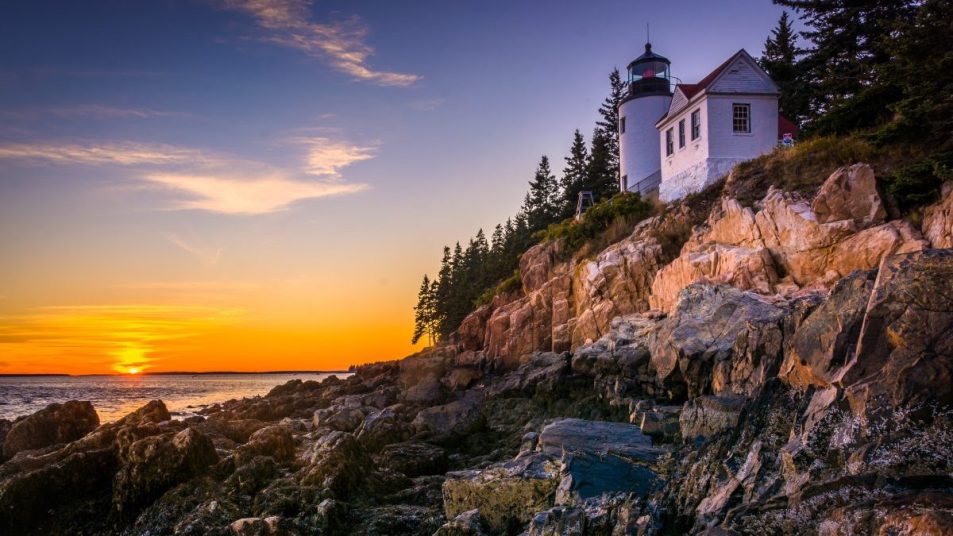
Water — seashores and watersheds, floodplains and falls — defines many of the East Coast’s most spectacular sights, alongside pretty ranges like the Great Smokies and the Blue Ridge Mountains. Decide which of these national parks along the East Coast should be your next destination.
1. Everglades National Park (Florida)
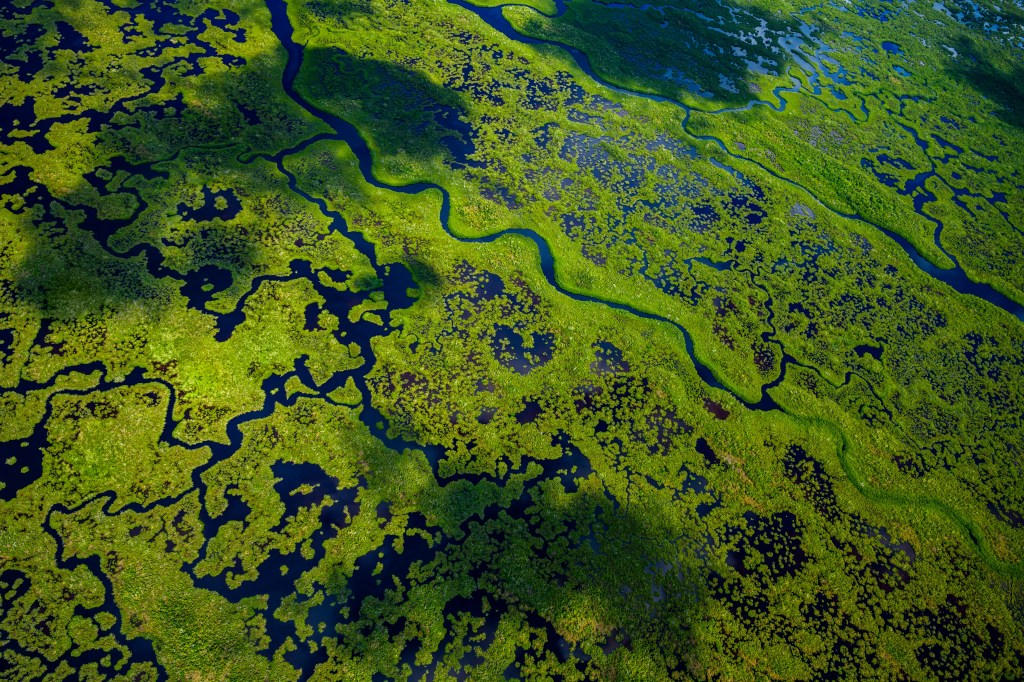
America’s tenth largest national park has no mountains, no glaciers, and no geysers. A vast, shallow watershed, it flows quietly, imperceptibly, for 100 miles, emptying into Florida Bay. Tucked in its endless marshes are 400 kinds of birds, more than 20 threatened wildlife species, and the most extensive mangrove ecosystem in the Western Hemisphere. This 1.5 million-acre area is Everglades National Park, the largest designated subtropical wilderness reserve in North America. Human development threatened to destroy the Everglades in the early 1900s. Thankfully, advocates came to the rescue, and Everglades National Park was born in 1947. Three unconnected entrances grant access. In Shark Valley, 35 miles from Miami, a park tram travels the 15-mile loop road, and a 65-foot observation tower lends 360-degree panoramas of the saw grass prairie and its wildlife. Everglades National Park became a UNESCO World Heritage site in 1979.
Along the Gulf Coast south of Naples, Everglades City is the launch pad for narrated boat tours of the pristine Ten Thousand Islands. Here, too, experienced paddlers embark on the 99-mile-long Wilderness Waterway Trail. To the south, the town of Homestead is the gateway to the remote Royal Palm and Flamingo areas. In Royal Palm, day-trippers walk the Anhinga Trail, where alligators and tropical birds are spotted by the dozens. Boardwalk trails and guided canoe trips lead explorers deeper into the Everglades in and around Flamingo, the southernmost spot in mainland Florida.
While animal lovers won’t find the grizzlies and other large mammals of the West here, they may be lucky enough to spot the endangered manatee, American crocodile, or Florida panther. In this famous “river of grass,” it’s a different type of discovery, but an unforgettable adventure all the same.
Visiting Everglades National Park
Florida’s dry season (December through April) is the time to go. Visitors will experience better weather, more wildlife, fewer mosquitoes, and more ranger programs and park amenities available. Four visitor centers are worth a stop. Pitch a tent at Long Pine Key or Flamingo campground. Find hotels and adrenaline-fueled airboat tours in Homestead and Everglades City. Click through for tips on planning a National Parks road trip.)
2. Cape Hatteras National Seashore (North Carolina)
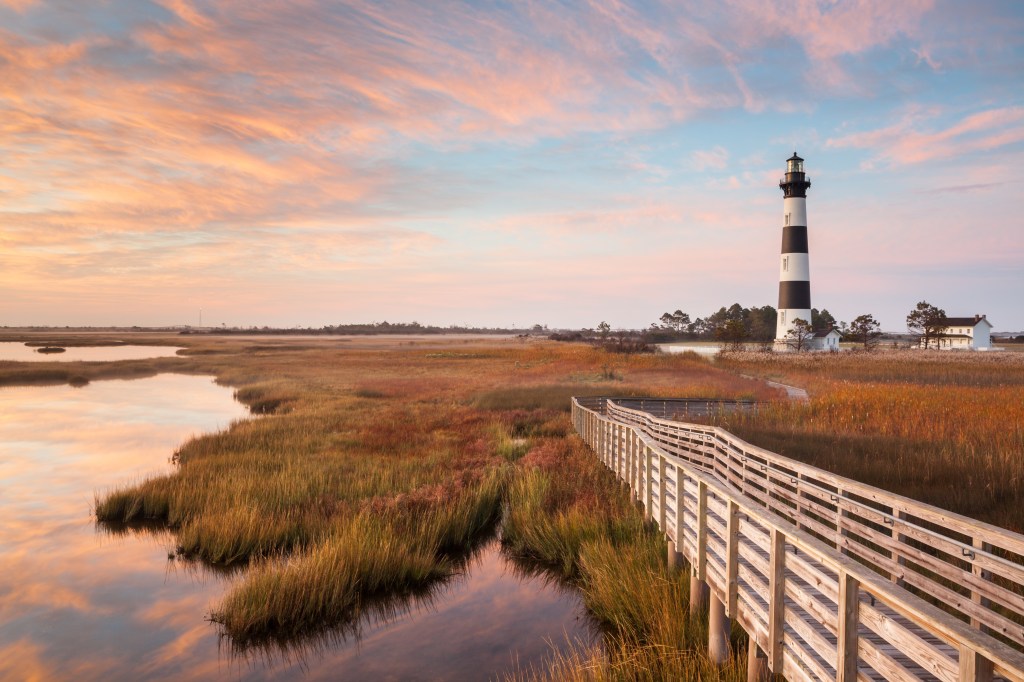
These days, it’s hard to find pristine beaches — free from development, the way nature intended — but that’s exactly what Cape Hatteras National Seashore delivers. As part of North Carolina’s Outer Banks, the protected area stretches for more than 70 miles, from Nags Head in the north to Ocracoke in the south.
The 30,000-acre seashore safeguards sections of three barrier islands: Bodie, Ocracoke, and Hatteras. Each boasts a historic lighthouse, constructed to guide ships through the “graveyard of the Atlantic,” where more than 600 vessels have wrecked since the 16th century. Even pirate lore endures here. Ocracoke was a known hangout of Blackbeard, who faced his final battle in the park’s Pamlico Sound.
Most of the seashore’s 2.6 million annual visitors are beach bound, but there’s plenty more to
do. Atlantic wave breaks offer some of the best surfing on the East Coast. Beginners hone their skills at Ocracoke and Bodie, while Hatteras offers more of a challenge. In the sound, adventurers can catch blue crabs, snorkel the calm water, or kayak to spot turtles and skates (the stingray’s cousin). Additionally, the 12-story Cape Hatteras Lighthouse is the tallest brick lighthouse in North America.
Three hiking trails lead through maritime forests, salt marshes, and shrub thickets that support more than 400 species of birds. And on Ocracoke, a herd of wild ponies — the descendants of ponies marooned by 16th-century shipwrecks — lives in a pen for protection from the highway (an adopt-a-pony program exists to help fund their care). Of course, after all the exploring, a relaxing and unspoiled beach awaits.
Visiting Cape Hatteras National Seashore
Visitor centers (one on each island) are open year-round. For warmer weather, lifeguard-manned beaches, and a chance to scale the Cape Hatteras and Bodie Island lighthouses (Ocracoke’s is not climbable), visit during summer. Camping is available April through November, and hotels and vacation rentals can be found nearby. Go in the winter to see seals hanging out on the beach.
3. Hot Springs National Park (Arkansas)
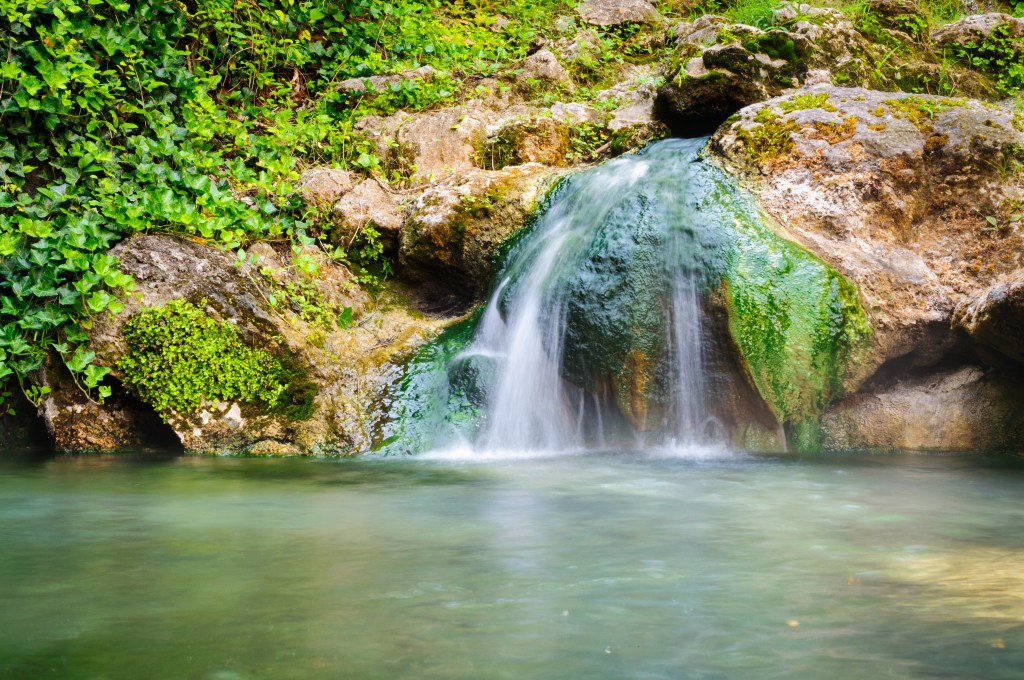
Fittingly called the American Spa, Hot Springs is the birthplace of the modern quest for wellness. Much of this unique national park sits within Hot Springs’ city limits, where people have tapped into the mineral-rich waters since Egyptians were building the pyramids. Rainwater from more than 4,000 years ago still flows through the springs, surging back up from the Earth’s crust so rapidly that it doesn’t have time to cool. Native Americans originally settled near what they called the Valley of the Vapors, and Spanish explorer Hernando de Soto rediscovered the springs in 1541, sending word back to Europe that a fountain of youth had been found in the New World.
The area became an official national park in 1921. A mere 5,550 acres, it is the country’s smallest national park. Today, 1.4 million visitors come to bathe in the same waters as former presidents, prohibition-era mobsters, major-league baseball players, and the elite jet set of yesteryear. At Buckstaff Bathhouse on Bathhouse Row, spa-goers slip into the thermal waters, which heat naturally to 143 degrees, before entering a steam room.
Other musts in Hot Springs include a trip to Hot Water Cascade, where the rocks are thick with rare blue-green algae. Take a drive along Hot Springs Mountain Drive. Also, try hiking across Sugarloaf Mountain on the Sunset Trail. In a world of overpriced facials and massages, a return to the earth at the American Spa might be just what the doctor ordered.
Visiting Hot Springs National Park
Drinking the hot-springs water is safe and encouraged. Visitors should “quaff the elixir,” as they used to say in the spa’s heyday — and bottle some to take home. Fountains are located near the corner of Central Avenue and Reserve Street, and in Hill Wheatley Plaza.
4. Biscayne National Park (Florida)
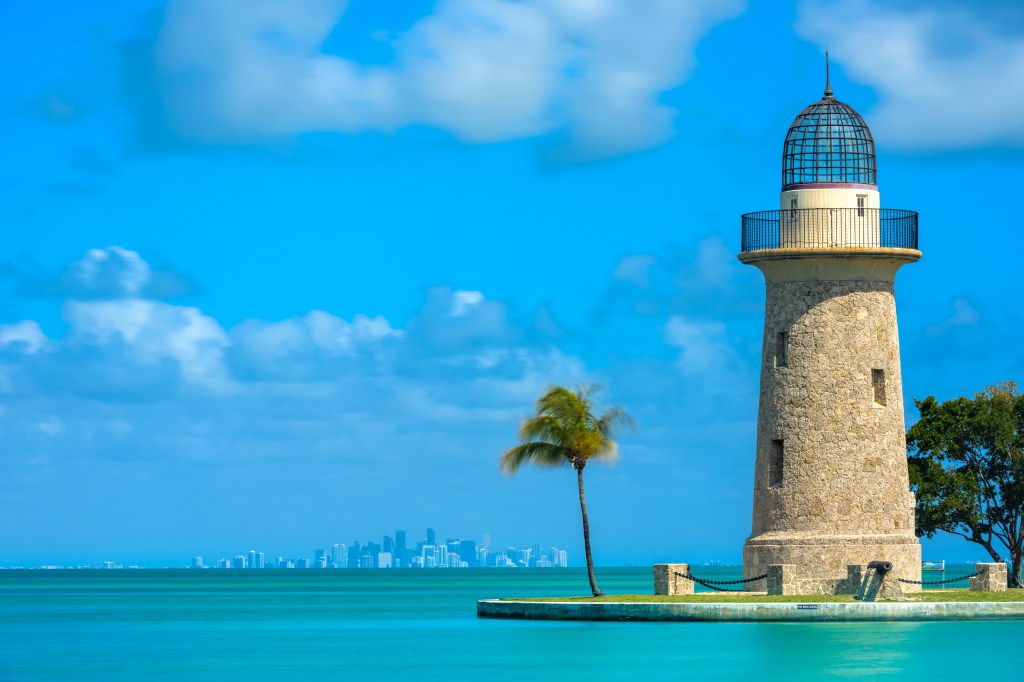
At Biscayne National Park, the main trail is for snorkeling, not hiking. Sturdy boots are traded for swim fins, and boats, not cars, are the main method of transportation. The 173,000-acre preserve stretches from Key Biscayne to Key Largo, and 95 percent lies underwater. But this park — which sees over 450,000 annual visitors and shelters the world’s third-largest coral barrier reef — was almost destroyed in the 1950s.
Developers envisioned hotels and highways and proposed dredging 8,000 acres and a 40-foot-deep channel through the bay. Conservationists lobbied to protect the site, including Herbert W. Hoover, Jr., who took congressmen on blimp rides to showcase the bay’s beauty. The creation of Biscayne National Monument in 1968 halted any further construction, and national parkhood was achieved in 1980. Explorers boat-hop to the uninhabited keys dotting the landscape, as well as the three main islands: Adams, Elliot and Boca Chita, the most popular. Boca Chita’s 65-foot ornamental lighthouse looks across to Miami. Also worth an excursion: the seven overwater shacks of Stiltsville, which has a storied prohibition-era past.
The main attraction is the Maritime Heritage Trail, which accesses prime snorkeling and diving spots, such as the circa 1878 Fowey Rocks Lighthouse. Buoys also mark six shipwrecks, including the Erl King. In the winter, lucky paddlers spy manatees in the turquoise waters — a prize for journeying to this watery wonderland.
Visiting Biscayne National Park
You’ll definitely need a boat to get beyond the Dante Fascell Visitor Center, but guided tours — from sightseeing to snorkeling to diving — depart from there daily. There is no park entry fee, unless you take a guided excursion or dock overnight to camp on Boca Chita or Elliot. Adams is day-use only. Visit between December and May to avoid hurricane season.
5. Great Smoky Mountains National Park (Tennessee & North Carolina)
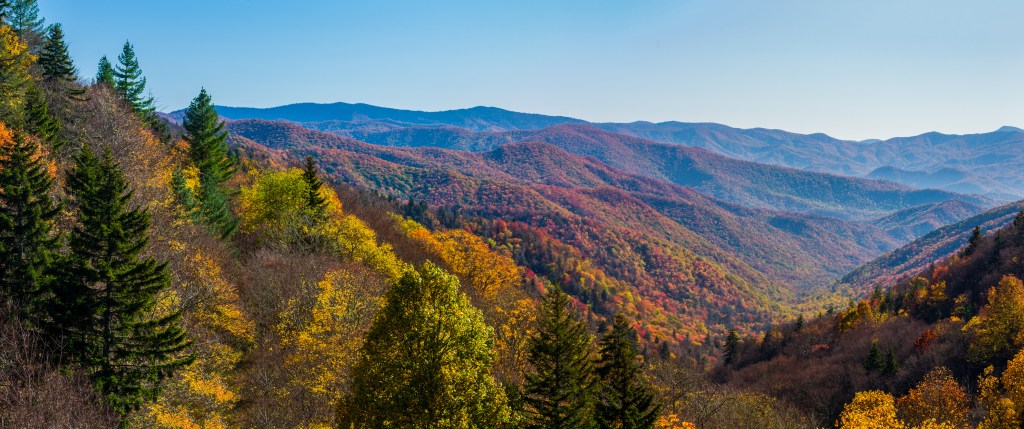
What makes Great Smoky Mountains National Park the country’s most visited, welcoming more than twice the number of people as any other park in the system? Is it the park’s location, less than a day’s drive from nearly everywhere in the East? Its free admission? Its status as a UNESCO World Heritage site, an International Biosphere Reserve, and the largest area of protected land east of the Rockies?
Arguably, the park’s distinctive beauty is the greatest attraction. Ridge after ridge after ridge fades into the horizon, exuding a smoky haze — the product of organic compounds let off by the area’s dense flora. Three main entrances are jumping-off points for forays into the national park, established in 1934. From Gatlinburg, Tennessee, the Sugarlands Visitor Center equips travelers to explore scenic landmarks like Laurel Falls, Rainbow Falls, and the Alum Cave Bluffs. The Great Smokies boast 90 historic structures, 100 waterfalls, and 100,000 types of flora and fauna. Visitors frequently spot deer, black bears, coyotes, wild turkeys, groundhogs, and raccoons in Cades Cove, the most-visited area of the park.
Farther west, the town of Townsend, Tennessee, is the gateway to the popular Cades Cove valley. Here, an 11-mile loop road takes sightseers past abundant wildlife, as well as the historic cabins, churches, and mills of early Southern Appalachian settlers. And from North Carolina, US Route 441 connects the town of Cherokee to the Oconaluftee Visitor Center, where a sprawling collection of historic buildings depicts everyday life on a 19th-century farmstead.
In the heart of the park, the 6,643-foot Clingmans Dome observation tower is the highest point in Tennessee. The vista — reaching from the vast Smokies into seven states beyond — brilliantly captures the area’s glory. From this transcendent viewpoint, it’s easy to see why GSMNP is America’s favorite.
Visiting Great Smoky Mountains National Park
Can’t choose from 800 miles of trails? Try Andrews Bald (3.6 miles round-trip), Charlies Bunion (8 miles round-trip), or 100-foot-high Ramsey Cascades, the tallest waterfall in the park (8 miles round-trip). Some 71 miles of the Appalachian Trail also cut through the park. The Cataloochee Valley is the place to see elk, which were successfully reintroduced to the area in 2001. Inside the park, stay at LeConte Lodge, accessible only by hiking. Or camp at one of 10 developed campgrounds. Twelve neighboring communities, including charming Bryson City, offer additional amenities.
6. Congaree National Park (South Carolina)
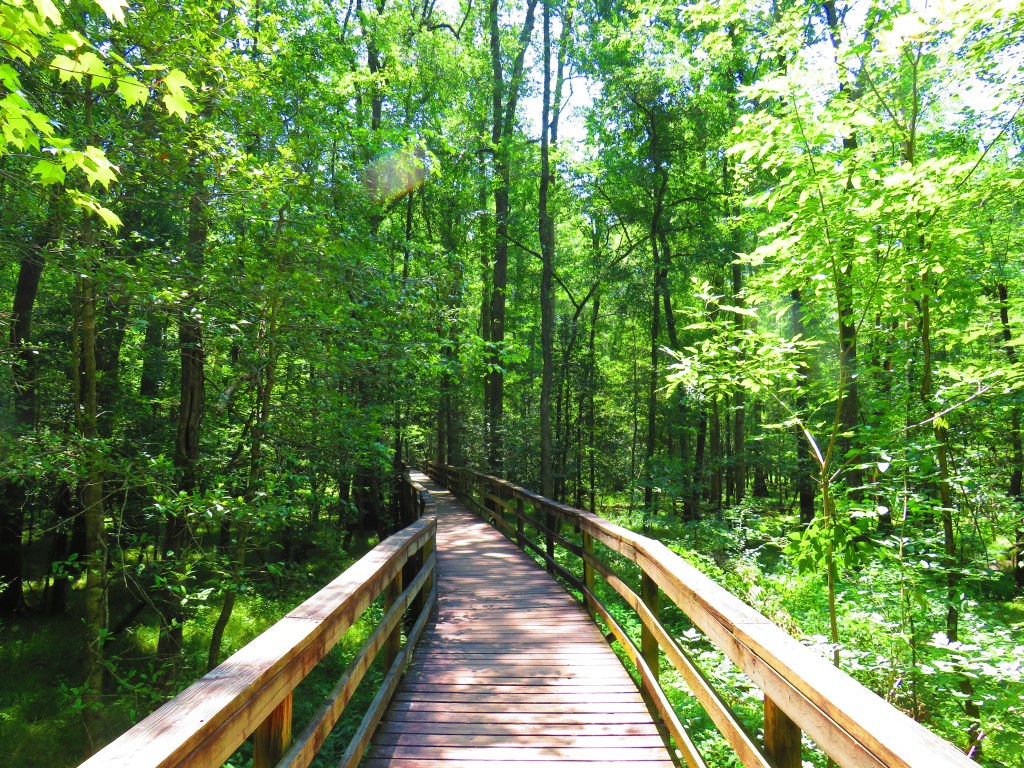
Trees are the superstars of this unlikely national park in central South Carolina, home to the largest old-growth hardwood forest in the Southeast. With an average canopy height of over 100 feet, the park contains 25 trees that are the largest of their respective species in the state — including a 167-foot-tall loblolly pine that’s also the biggest tree of its kind in the country. The biggest bald cypress in the park (and state) measures 127 feet tall.
These arboreal giants were attractive to loggers in the 1890s, but because the area is mostly inaccessible, the work was halted. A group of conservationists worked to officially protect the site, which became a national monument in 1976. National park status came in 2003, and some 160,000 annual visitors explore this floodplain forest.
Sightseers can hike several flat trails that start at the visitor center. The Boardwalk Loop Trail (2.4 miles) weaves between massive water tupelo trees, oaks, and maples. Deer and wild turkeys can be spotted on the Oakridge Trail (6.6 miles), while the Weston Lake Loop Trail (4.4 miles) leads to Cedar Creek, home to otters and wading birds. Throughout the park, explorers can spot knobby cypress knees. Legend holds that these woody growths are elves that spring to life after dark. Yet even inanimate, they’re a fascinating sight in this wet woodland.
Visiting Congaree National Park
Congaree is a 30-minute drive from downtown Columbia, where you can find lodging and gear rentals. BYO canoe, or reserve a ranger-guided tour of the Cedar Creek Canoe Trail. Visit May through October for the best hiking conditions, as the trails are usually flooded during other months of the year. Bug spray is a must: The park has a mosquito meter ranging from 1 (All Clear) to 6 (War Zone). Spring and fall offer the best weather and fewer pests.
7. Mammoth Cave National Park (Kentucky)
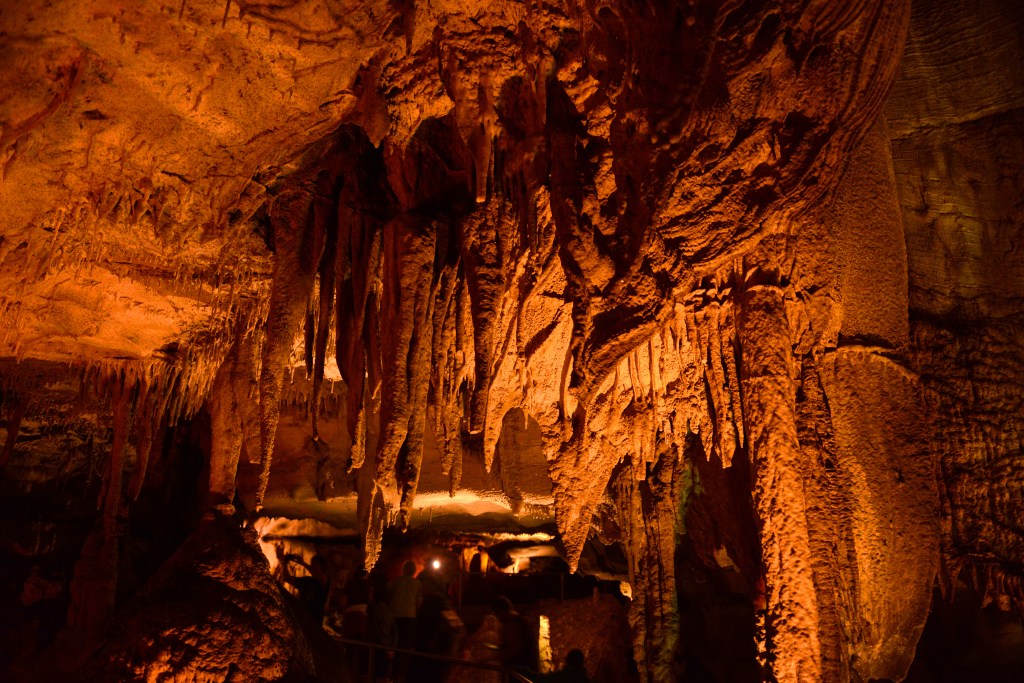
Tucked inside the Earth within the Green River Valley lies Mammoth Cave, where more than 400 miles of mapped cave — and innumerable unexplored passageways — make it the longest cavernous system in the world. The first souls entered Mammoth Cave 4,000 years ago and used it for shelter and gathering minerals. European hunter John Houchins is credited with rediscovering the cave around 1800. Settlers used it as a source of saltpeter for gunpowder during the War of 1812, as well as a tuberculosis hospital in the 1840s. Throughout the 19th and early 20th centuries, slaves mapped the majority of what has been explored in Mammoth Cave and acted as guides for early tourists.
Lanterns light the way as modern cavers pass pleated drapes of limestone and a staggering dripstone formation called Frozen Niagara. Around each craggy corner, other sights emerge: the Snowball Room, where large white balls of gypsum cover the ceiling, and Devil’s Looking Glass, a slab of stone on which early explorers drew charcoal petroglyphs.
More discovery awaits aboveground: 70 miles of hiking and biking trails, as well as water-play on the Green River. Park rangers lead 10 different tours inside Mammoth Cave. Mammoth Cave became a national park in 1941 and was later declared a UNESCO World Heritage site and an International Biosphere Reserve. Today, this labyrinthine Kentucky karst draws more than 550,000 annual visitors eager to uncover its secrets.
Visiting Mammoth Cave National Park
It’s about 54 degrees inside the cave, and plenty of spots hold water, so wear a sweater and shoes that can get wet. Choose from several cave tours that vary in difficulty; some include upward of 500 stairs. Three developed campgrounds and the Lodge at Mammoth Cave operate inside the park.
8. Niagara Falls (New York)
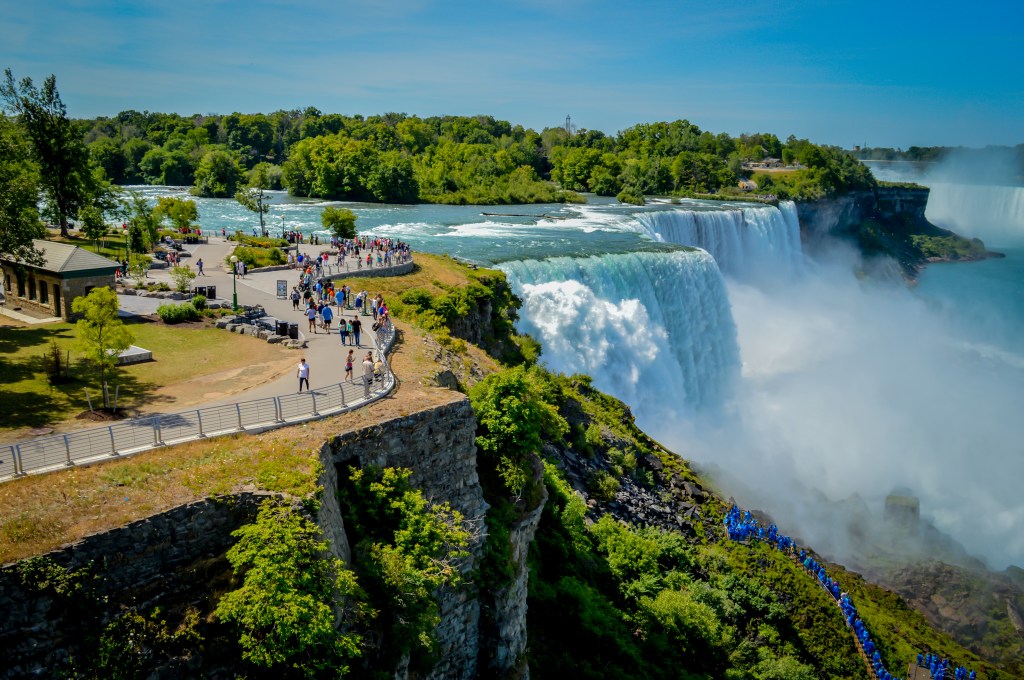
Holding a rightful spot on many bucket lists, Niagara Falls lives up to the hype. During peak season, nearly 650,000 gallons of water tumble over the falls each second — and with a vertical drop spanning more than 165 feet, Niagara has the highest flow rate of any waterfall in the world. The water that spills over Niagara Falls comes from four of the five Great Lakes.
Lying between New York and Canada, Niagara Falls is a collection of three cascades: American Falls, Horseshoe Falls, and Bridal Veil Falls. When it originally formed, Niagara’s wall of water was about 7 miles downstream from its current location, and erosion continues to push the falls farther upstream at a rate of about a foot a year.
With an unmistakable roar that can be heard from miles away, Niagara Falls and its surrounding region played roles in the War of 1812 and the Underground Railroad before becoming a vital source of hydroelectric power. Today, the falls represent 20 percent of the drinking-water supply for the United States and Canada — continuing to be, as British author Arthur Young once said, “the key to the whole continent.” Niagara Falls State Park is the oldest state park in the US.
Nine-and-a-half million people a year descend on this 400-acre state park to see the falls and explore the surrounding area. Spots like Goat Island, with its straight-down views into the deluge, offer Instagram-worthy photo ops for days. Other exceptional viewpoints range from a helicopter and an observation tower to the “Hurricane Deck,” accessed via a cave elevator and a series of wooden walkways. No matter the angle, Niagara Falls is a once-in-a-lifetime spectacle and deserves a big checkmark on the travel wish list.
Visiting Niagara Falls
A trip on Maid of the Mist, which has been towing passengers to the base of the falls since 1846, is a must. There’s nothing quite like feeling the spray of the water coming off Horseshoe Falls as the rapids of the Niagara River churn below. Be advised that you will get drenched on the boat ride. The tour operator provides souvenir ponchos, but make sure to wear shoes that can get wet. Also remember that while many of the iconic sights lie on the American side of the falls, there’s plenty to explore in Canada as well — so bring your passport.
9. Acadia National Park (Maine)
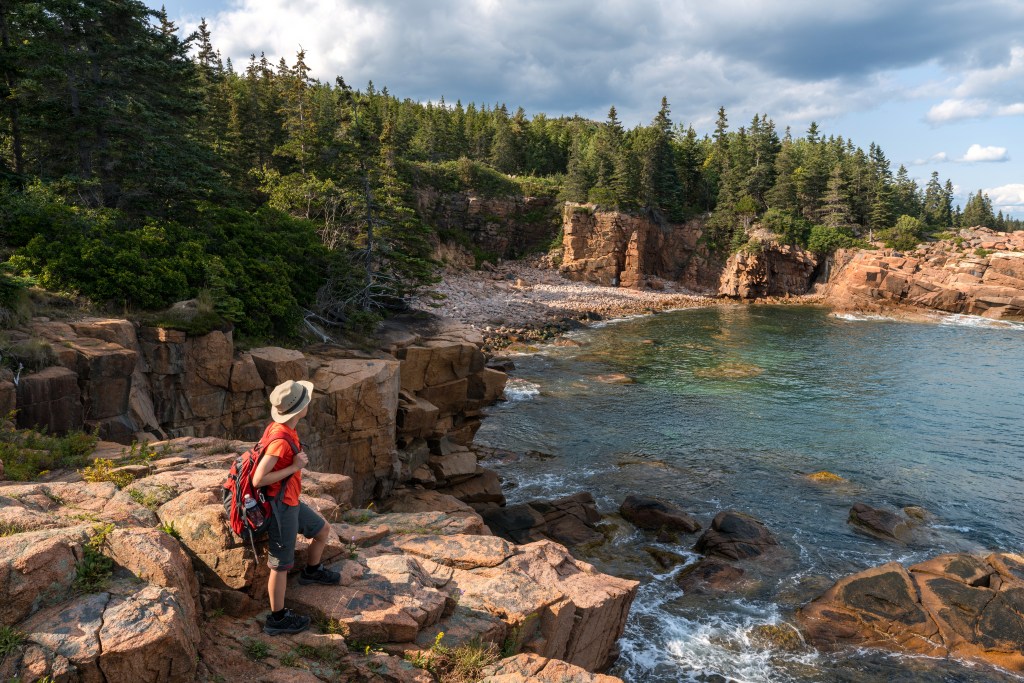
From October 6 to March 7 every year, the rising sun kisses Cadillac Mountain before any other spot in the US. At 1,530 feet, the famous summit is the highest mountain on the North Atlantic seaboard — and its home is Acadia, the first national park to open east of the Mississippi. More than 3.3 million visitors a year come to admire Acadia’s 40-plus miles of rocky shoreline.
Elsewhere on Mount Desert Island, visitors can walk the Ocean Path from Sand Beach to Thunder Hole. Here, waves entering a partly submerged sea cave boom like thunder at certain times of day. Farther on, Otter Cliff’s 110-foot granite bluff grants epic ocean views. Some 24 pristine ponds, including serene Jordan Pond, dot the glacier-carved interior. And weaving through the park’s 48,000 acres are 45 miles of car-free carriage roads, funded by John D. Rockefeller Jr. from 1913 to 1940.
Rockefeller and affluent summer residents donated land that would become Sieur de Monts National Monument in 1916. Redesignated Lafayette National Park in 1919, it took its current title in 1929. Today, Acadia is a household name, and the landscape is considered the Crown Jewel of the North Atlantic Coast.
Visiting Acadia National Park
Visitors can hike to the summit of Cadillac Mountain (7.7-mile loop) or simply drive. Start your adventure at the Hulls Cove Visitors Center, and coast along the 27-mile Park Loop Road. Acadia has two campgrounds and no lodging, and many park roads close during the winter. Don’t miss popovers and tea at Jordan Pond House restaurant, open seasonally. More dining and lodging options are available in Bar Harbor. The hop-on/hop-off Island Explorer shuttle is free.
10. Shenandoah National Park (Virginia)
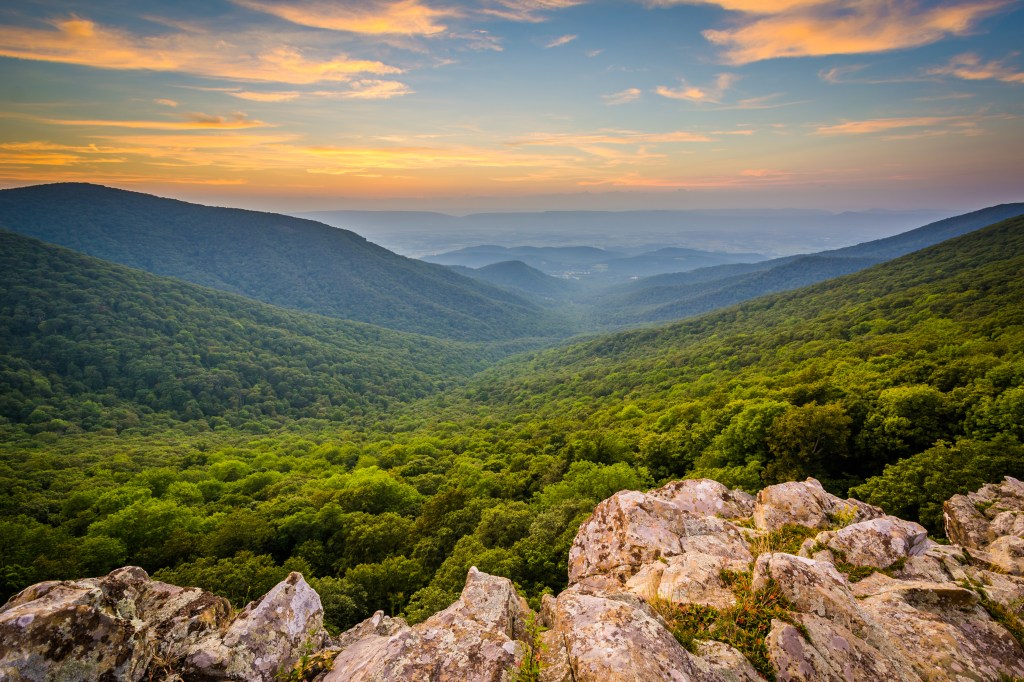
Located 75 miles west of Washington, D.C., Shenandoah National Park is less about the destination and more about the journey — one that starts on its main thoroughfare, Skyline Drive. A National Scenic Byway, it winds 105 miles along the crest of the Blue Ridge Mountains, with 75 lookout points along the way. To the east are the foothills of Virginia’s Piedmont region; to the west, the Shenandoah Valley.
The 1.4 million-plus visitors who drive it each year owe a debt to the men of the New Deal’s Civilian Conservation Corps. They built the snaking road, as well as scenic overlooks, trails, and several structures now listed on the National Register of Historic Places. They also planted the Fraser firs, red spruces, and table mountain pines that line the route and burst into fiery colors every fall.
To truly experience the glory of the park’s nearly 200,000 acres, visitors should hit one of the more than 500 miles of hiking trails. They range from simple to strenuous — and include 105 miles of the famed Appalachian Trail. Walks lead up mountains, down canyons, and past streams and old homes that once belonged to the area’s settlers (residents were relocated before Shenandoah was designated as a national park in 1935). The most popular — and risky — hike is Old Rag Mountain (9 miles round-trip), which involves a rock scramble to its 3,284-foot summit and lofty view.
Several trails lead to waterfalls, including 93-foot Overall Run Falls, the tallest cascade in the park (6.4 miles round-trip). Alas, the hike’s climb of 1,850 feet happens on the way back. But once in the car, the memory of the views will erase that of the strenuous trek uphill.
Visiting Shenandoah National Park
Four park entrances are located along Skyline Drive, as well as two visitor centers, at mile 4.6 and mile 51. Lodging options include guest rooms, suites, and cabins at Lewis Mountain (mile 57.5), Skyland (mile 41.7), and Big Meadows (mile 51). While it’s smart to enter the park with a full tank, mile 51 does have a gas station. Restaurants and grab-and-go food options are available at Skyland and Big Meadows.
11. New River Gorge National Park (West Virginia)
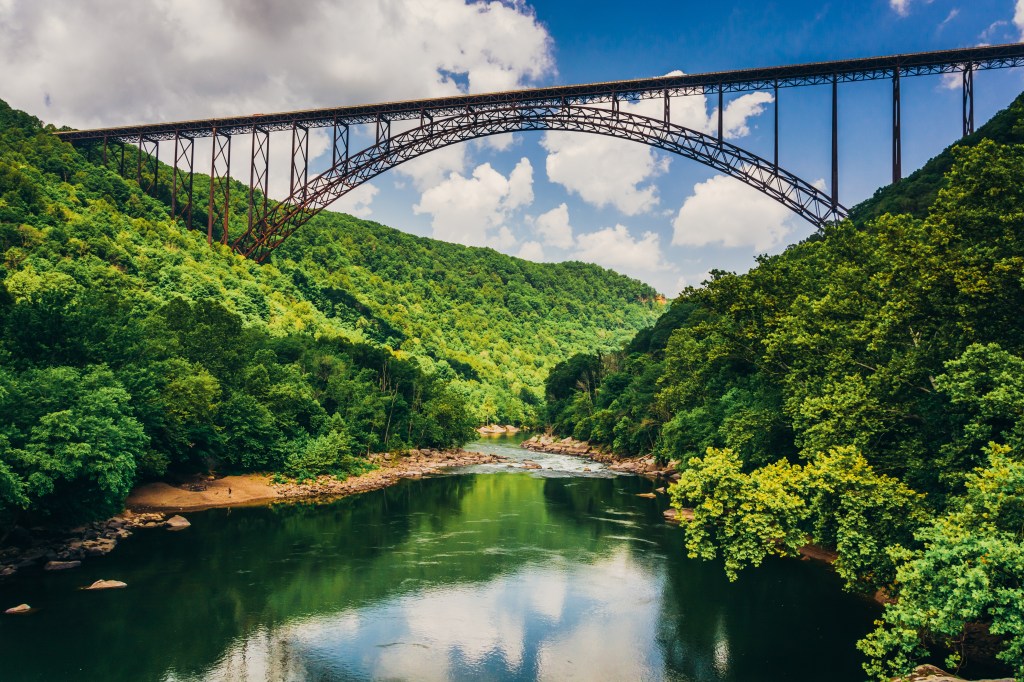
It’s our newest national park (it was designated one in December 2020, part of a pandemic relief bill), but paradoxically, it’s also one of the oldest places in the country. The river that twists and turns so dramatically through the park’s center is thought to be the second oldest on Earth; fossil evidence suggests it could be 320 million years old. Fast-forward a few epochs, and today, the New River, which drops 750 feet over 66 miles, draws whitewater rafters, who brave the Lower New, a 13-mile stretch of Class IV and V rapids. Meanwhile, the steep canyon walls beckon rock climbers, who rate the 1,500 climbing routes as among the best on the East Coast.
Prefer your vacations with less of an adrenaline rush? Hike trails that range from 1⁄4 to 7 miles, or ride a bike on the 12.8 miles of Boy Scout-built paths. The third Saturday of October is Bridge Day at New River. Activities include BASE jumping, rappelling, and concerts (and food vendors). You can also kayak, canoe, or take a (commercial) boat trip on the more placid stretches of the river.
Also not to be missed: a drive to Sandstone Falls, a 1,500-feet-wide waterfall with a maximum drop of 36 feet. The route takes you past scenic outlooks, trailheads, and historic sites that are reminders of when the 73,000-acre park was home to hundreds of mining hamlets, many of which are now ghost towns. Also noteworthy: the African American Heritage Auto Tour Route, which highlights the role Black families played in making this area a center of coal production. The park also lies in the north-south flyway for migratory birds; be on the lookout for bald eagles and peregrine falcons.
Visiting New River Gorge National Park
While there’s only primitive camping in the park, many of the surrounding towns offer lodging. But why not really get away from it all on your own private island? The Cabin on Coney Island, with its own trails and sandy beaches, holds up to 10 people, starting at $351/night on airbnb.com.
A version of this article appeared in our partner magazine Complete Guide to the National Parks.












